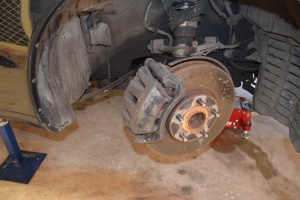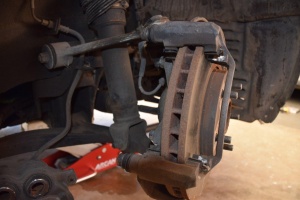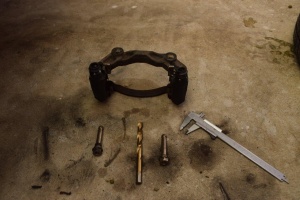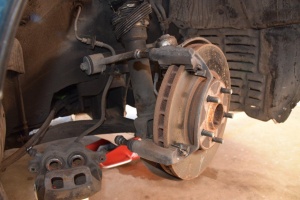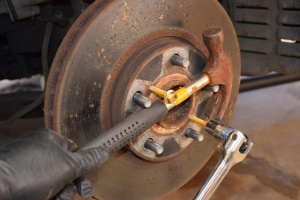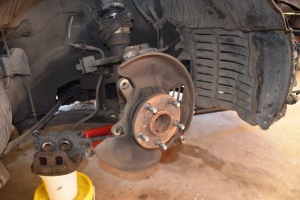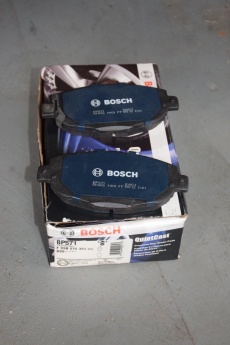Brake Pads & Discs / Rotors
System Design
The braking system is largely a conventional design (ie Disc brakes front & rear), though the ABS & TRC systems use a (shared) pressure accumulator.
Changing Brake Pads
The process for changing brake pads is similar to that for many other vehicles, ie:
- slightly loosen the wheel nuts before jacking up the vehicle
- jack up the vehicle and support it on jack stands
- remove the wheels
- remove the pads
- clean eg the brake pistons so that they do not contaminate the inside of the cylinders when pressed in
- check the operation of the sliding pins (the pins often seize and will need suitable grease. NB: The rubber boots also deteriate and may need replacement. The rubber bushes on the pins do not wear much but can easily be lost when the pins are removed. If the sliding pins are stuck, it may help to remove the mounting bracket first.
- press in the brake pistons so that the new (and thicker) pads will fit. NB: There have been reports of this causing problems with the ABS in which case eg releasing the "reverse" pressure via the bleed value may be necessary
- install new brake pads, applying suitable grease in the appropriate spots
- making sure the anti-rattle springs are re-installed (or replaced if they have been lost)
- bleed the brakes
- reinstall wheels, lower vehicle, tighten (but not over-tighten) the wheel nuts
- test drive and "bed in" the brakes
Specifications and part numbers
Front
Toyota part number is ________ This is shared with the JZZ30 (Twin Turbo) Soarer, and also the same as on the US-spec SC400. It is however different to the UZZ31 (Airbag V8) Soarer Part numbers from other vendors include: Bosch
Rear
Toyota part number is ________ This is shared with the ??? Part numbers from other vendors include:
Changing Brake Discs / Rotors
To remove and replace the (front) discs:
- proceed as if you are removing the brake pads as per above, though it may not be necessary to actually remove the pads
- remove the caliper mounting bracket and remove the caliper from the disc. NB: Support the caliper asembly so that there is no pressure on the brake hose as this remains connected)
- remove the disc - it is "free-floating" so it is actually not held in by anything other than rust. To release it from the hub, screw in 2 x M8 bolts into the release holes, which will then gently lever the disc away from the wheel hub. (Hitting the disc even with a rubber hammer is not recommended).
- clean up any rust etc so that the new disc will fit flush with the hub
- install the new disc and temporarily hold it in place with 2 or three of the wheel nuts
- preferably, measure the "run-out" to ensure that the disc surface is flat and the disc is installed correctly
- re-install the brake caliper etc
The process for the rear discs is conceptually similar though the handbrake components will also need to be taken into account.
Specifications and part numbers
Front
Toyota part number is 43512-24051 This is shared with the JZZ30 (Twin Turbo) Soarer, and also the same as on the US-spec SC400. It is however different to the UZZ31 (Airbag V8) Soarer Amayama show 43512-24071 as a replacement. Ebay shows Brembo 25555 as a replacement. Lexus Part Number: 43512-50100 Is also referenced, with suggestion that this also fits various other lexus models
Rear
Toyota part number is ________ This is shared with the JZZ30 (Twin Turbo) Soarer, and also the same as on the US-spec SC400. It is however different to the UZZ31 (Airbag V8) Soarer Part numbers from other vendors include:
Bleeding the brakes
Purpose of bleeding the brakes
The purpose of bleeding the brakes is to ensure that there is no air in the brake fluid. This is important because fluids (eg brake fluid) is not compressible, but air is. If there is air in the system, the brake pedal will feel "spongy" rather than firm and brake performance will be negatively affected.
Process for bleeding the brakes
In summary, the process for bleeding the brakes is to let out the brake fluid (and any air bubbles) though the bleed nippes at each wheel (and if necessary at other locations in the brake system) without letting new air enter the system.
Flushing the brake fluid
Purpose
The purpose of flushing the brake system is to fully replace the brake fluid in the system. This is important because brake fluids are designed to absorb moisture (which hels to eg reduce the risk of rust in the braking system) but causes a problem in that the water in the fluid can boil if it becomes hot enough. When this occurs during breaking, the water turns into steam. Since steam is a gas rather than a fluid, it is compressible and the brakes will therefor behave as if they have air in the system.
Process
In summary, the process is:
- remove old brake fluid
- clean the reservoir
- add new fluid of suitable specifications
- bleed the brakes
Brake Fluids
Toyota recommends DOT _ brake fluid for the Soarer In principle, DOT 3 & 4 are said to be compatible, and although DOT 5 is not compatible, 5.1 may be.
"Bedding in" the brakes
The purpose of "bedding in" the brakes is to ????. Refer to the brake manufacturer's instructions for specific recommendations, which are typically along the lines of:
- perform moderate brake application from a speed of say 60km/hr to say 15 km/hr, ie do not let the vehicle fully stop
- allow the brakes to cool somewhat by driving say 500 metres
- repeat the above about 10 times
Safety
Safety is paramount when working on any vehicle, and particularly on the brakes. Areas to consider include:
- If you are not sure what you are doing, get a professional to do it
- Ensure the vehicle is safely raised (using stands rather than a jack) before getting under any part of the vehicle
- Brake pads (and the associated dust) no longer contain asbestos, but the fine dust is unlikely to be good for you...
- Brake fluid damages car paint. It's unlikely to be good for people, either...
- Bleed out any air that may have entered the brake system before considering the job complete
